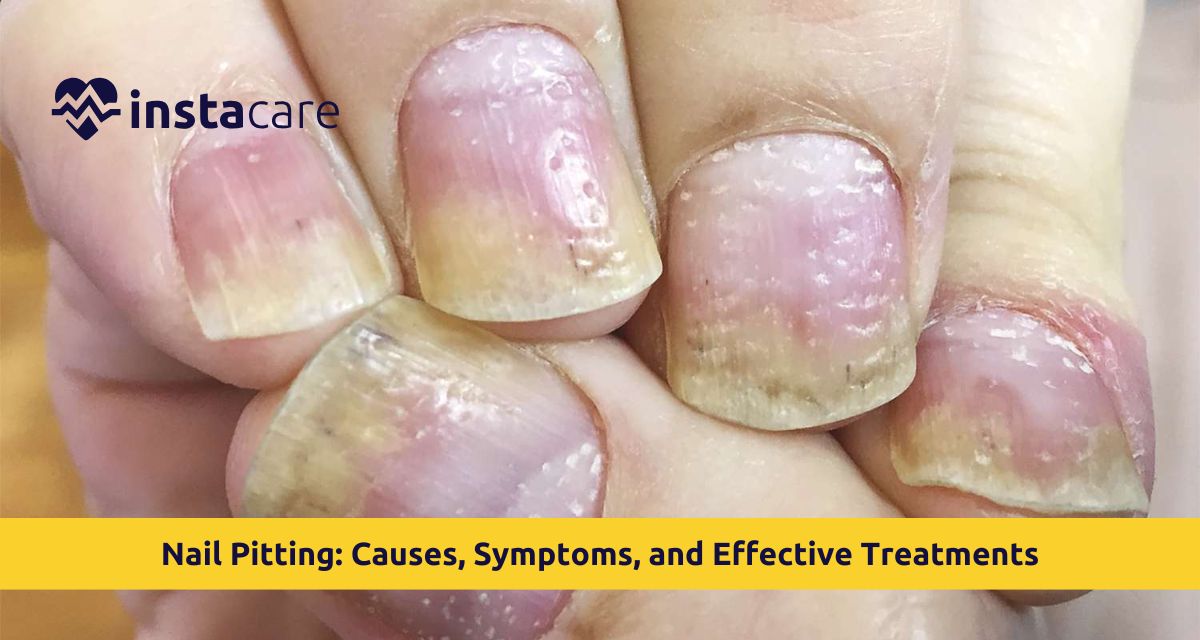What Is Nail Pitting?
Nail pitting is the appearance of small pinhead-sized pits on the toenails or fingernails. The pits are superficial and shallower than a millimeter and range from a few scattered pits to dozens across the nail. The disorder results from disruption in cells in the nail matrix during nail formation. Nail pitting vs ridges is an important distinction. Pitting refers to small, round depressions that are akin to minute holes, whereas ridges are akin to lines vertical or horizontal on the surface of the nail.
Common Causes of Nail Pitting
Psoriasis and Nail Health
Nail pitting psoriasis is the most common cause of such an abnormality and presents in almost 50% of psoriasis and in as many as 80% of psoriatic arthritis patients. Psoriasis is an autoimmune disorder with increased turnover of skin cells and, in nail matrix disease, there is characteristic pitting. The pitting also tends to follow the overall severity of psoriatic disease.
Nail pitting and autoimmune diseases are also directly associated with pitting of nails. Nail pitting in alopecia areata, an autoimmune disease leading to loss of hair, is observed in about 10-66% of the patients having the disease. The rest of the diseases in this group are
eczema, reactive arthritis, and connective tissue diseases.
Nutritional Deficiencies
Nail pitting vitamin deficiency is also a major cause. Zinc, iron, and some B vitamins deficiency might be observed to affect the structural change of the nails and abnormal growth resulting in nail disorder.
Thyroid Disorders
The association between miliary pitting of the nails and nail pitting and thyroid disease has been made. Both hyperthyroidism and hypothyroidism can affect the destiny of nails until brittleness, alteration of the growth rate, and pitting in certain situations.
Other Etiologic Causes
Pitting miliary and nail pitting and fungal infections can sometimes masquerade each other, but fungal infection also produces other symptoms in the form of thickening and discoloration. Trauma and drugs are also causes of nail pitting.
Associated Symptoms and Conditions
Nail pitting symptoms go to the extent of being invisible pits. Discolouration, thickening or destruction of the nail, delamination of the nail from the nail bed, horizontal or vertical ridges, brittleness of the nail, oil drop lesions in the nail, joint swelling or tenderness in psoriatic arthritis, skin lesion in eczema or psoriasis, alopecia areata patterns of hair loss are to be observed depending on etiology.
Distribution and severity of pitting can be diagnostic indicators. Shallowness, minuteness, and spottiness of pitting most commonly lead to psoriasis, but widespread and deep pits may point in another direction.
Diagnosis: How Doctors Identify Nail Pitting
Nail pitting diagnosis is made through a thorough examination of the nails and surrounding skin. Your doctor or dermatologist will observe the pattern, depth, and size of pitting and also whether any other nail or skin condition is present or not.
The actual procedures will most likely include:
- Screening in the course of your medical, autoimmune or skin disease family background, and previous exposure or recent medication
- Nail clippings to grow out to culture for fungus
- Blood tests to look for autoimmune markers or nutritional disease
- Thyroid function tests
- Rarely, a nail biopsy to look at under the microscope
Early intervention is necessary since nail pitting can be one of the earliest signs of reversible systemic conditions if addressed early. When to see a doctor for nail pitting is when nail pitting is sudden or acute in duration, occurs with joint pain or diffuse skin lesion, affects more than one nail or becomes large in extent, or occurs with associated splitting or pain of the nail.
Treatment and Management Options
Medical Therapies
Nail pitting treatment is very heterogeneous depending on etiology. In nail disease associated with psoriasis, direct local application of corticosteroids to the nail bed and perinail skin will reduce inflammation. Vitamin D analogs like calcipotriol will reduce excess cell proliferation. Systemic medications like biologics, methotrexate, or cyclosporine are employed in cases of severe or moderate severity to manage global disease activity.
In nutritional disorder or thyroid disease, the etiology is reversible with hormone replacement or supplementation and will in the majority of cases result in gradual restoration of normal nail health. In those in whom fungal infection is inducing or worsening pitting of the nails, antifungal treatment should be employed.
Supportive Therapies
Intralesional injection of corticosteroid into the nail matrix is helpful for generalized pitting that is localized, but is not comfortable. Phototherapy using high-intensity ultraviolet light can be helpful to specially selected patients with psoriatic nail disease.
Home Remedies and Preventive Care
You can be instructed to treat how to treat nail pitting naturally as an adjunct to medical therapy:
Nutritional Support:
Offer diet or supplement with adequate biotin, zinc, iron, and vitamins A and E
Omega-3 fatty acids may reduce inflammation
Nail Care Habits:
- Trim nails as short as they can possibly be
- Lubricate nails and cuticles regularly with vitamin E oil
- Steer clear of harsh nail creams and harsh manicures
- Wear gloves when using cleaning products
Lifestyle Modifications:
- Practice stress reduction through yoga or meditation
- Eat a healthy diet full of fruits, vegetables, and lean protein
- Eat adequate food to maintain healthy nails in general
Nail pitting is a powerful indicator of general health and could be an indicator that is an early warning sign of disease that requires some form of medical attention. It can be psoriasis, autoimmune disorder, thyroid disorder, or malnutrition, but if you are informed about the etiology, you can be treated appropriately.
Conclusion
Though hard to completely correct and takes a few months as nail damage is cumulative, optimal outcomes are achieved with professional and home supportive therapy together. In case you notice worsening or new pitting of nails, especially if accompanied by other signs and symptoms, avail yourself of the services of a dermatologist for proper evaluation and appropriate therapy.
Please book an appointment with the
best Dermatologist in Lahore, Karachi, Islamabad, and all major cities of Pakistan through
InstaCare, or call our helpline at 03171777509 to find the verified doctor for your disease.

